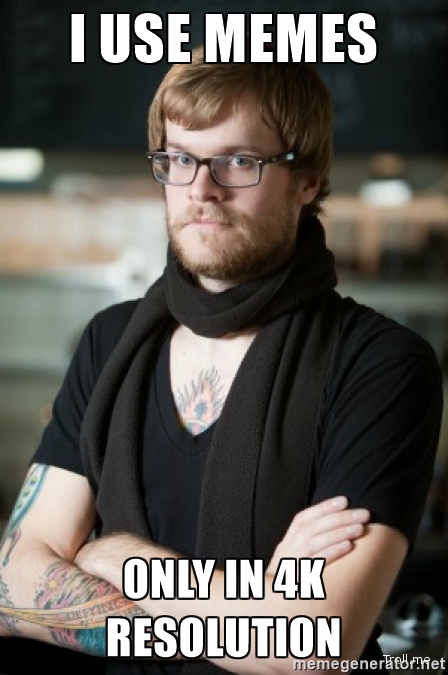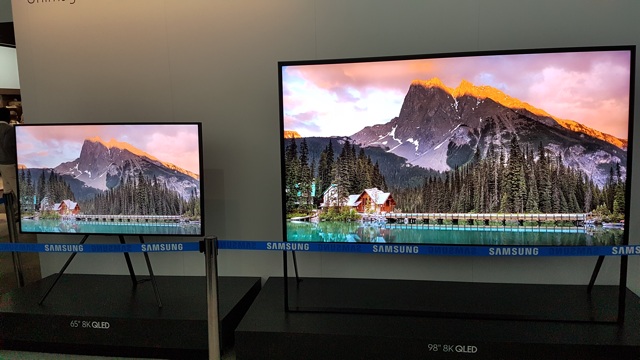Who needs 8K anyway? That is the question I asked myself as we were unpacking our new RED camera earlier this month. It was an interesting question and I immediately had some thoughts, but I took it upon myself to dig a little deeper and share my findings with you all. Now, this is not a simple answer right now and the technology is progressing so fast that it sometimes it feels like you can’t answer one question before another pops up. But seriously… 8K?
If you’re a film student, work in the motion picture industry, a gamer, or just not living under a rock, you know that this year is when 4K is going to be the big push at your local big box and electronics stores. Prices are curbed now to the point where even the most jaded skeptics, albeit still preserving their opinion that 4K is not discernable in a consumer living room, have to concede that UHD is now entering the realm of affordability. With 50-60in 4K televisions starting at around $500 from companies like Vizio and Insignia. It’s no longer a novelty or reserved for early adopters on the cutting edge of consumer tech. It is now the television that every electronics store associate will offer first to Uncle Bob looking for a new TV. As of right now, one of the biggest consumer electronics retailers has 21 – 4K Televisions available for purchase and 10 – 1080P Televisions for purchase. Major online streaming companies like Netflix and Amazon Prime Video are only accepting 4K HDR deliverables for any of their proprietary shows currently releasing. So like it or not, the general conversation seems to be steering away from the viability of 4K now and toward what the Wide Color Gamut and 10-bit color depth can bring to the table.

Admittedly, there is a point where you’d be hard pressed to find the difference between HD and 4K, and the variables that affect this are screen size and viewing distance. A rough calculation for the sweet spot is for every 10” of screen size, you want to be about the same in viewing distance away. This rule tries to keep the central viewing angle for a human eye, which is on average 50 degrees before hitting a peripheral view, filled with the entire display; hopefully resulting in a more immersive experience. If your head hasn’t exploded yet, then you might be interested in learning more about that. RED has a very (very) in-depth article talking about all of the technical details on resolvability and resolution linked here.
So this brings us back to the question: Who needs 8K anyway? What’s the point of all these new higher resolutions shooting formats? I think the answer lies less in the way the image resolves, but the implementation of how we use the images. If we accept that the average viewer sits about 8’-9’ from their 50in+ television and are out of the optimal zone for viewing, this may not be a huge deal for most people. For a dedicated setup like a home entertainment center, the benefits may not be entirely cultivated, which may be why HDR and WCG (Wide Color Gamut) are more and more prioritized in consumer display manufacturing than pushing the resolution boundary.
 Samsung 65” and 98” 8K QLED Televisions.
Samsung 65” and 98” 8K QLED Televisions.
Credit: mybroadband.co.za
With CES ending just last month, we got to see what manufacturers are pushing for in the consumer arena, and in terms of display technology, it seems like we are headed for 8K production models coming out by the end of 2017. However, that doesn’t mean 4K is going down the drain. Many display companies are focusing on 4K monitors and televisions with OLED panels which can produce a much deeper contrast ratio due to the ability to turn individual pixels on/off rather than relying on local dimming or any sort of array control to produce true blacks. Pair that with true 10-Bit color space and you have yourself the next iteration of in-home 4K televisions (A lot of the cheaper models that were on sale during the holiday season are 8-Bit models). This standard of final output makes it even more important now to consider high-quality 4K and HDR workflows during video production.
HDR vs Standard Dynamic Range
 Credit: Business Insider
Credit: Business Insider
Since 4K is the new normal output, how do you deal with that in production? Answer: 8K! When 1080 was the norm, everyone needed to shoot 2K for flexibility in post. Then ultimately it became 4K. A common answer from our customers to the question of, why 4K, has always been the ability to crop in or stabilize during post-production. Well if you are shooting 4K and the output is eventually 4K, how do you crop in? You guessed it, 8K.
With 4K becoming the new norm, that also has ramifications in visual effects and in general, the higher the resolution, the more flexibility you will have over your image. So for the application of color correction, animation, and visual effects, 8K can be extremely valuable. Can your system handle the workflow? That is a question for a different blog.
In terms of the cinematic experience, outside of the desire for more control in post, the answers are not quite as simple. Film has always been seen as the OG method of cinematic image capture; the standard bearer if you will. In this new digital age, DP’s will go to great lengths to maintain that same cinematic aesthetic, incorporating a plethora of techniques to muddy up and add a human element to the digital medium; like using old, squeaky lenses or trying different combinations of filters together to manipulate the contrast and detail. I can wholeheartedly empathize with why Purists argue for retaining a certain format and why people in the industry really like the way film handles grain and texture. However, there is a counterintuitive comedy in the desire to maintain that standard and the progression of the capturing technology that keeps becoming clearer and clearer with every upgrade in resolution. So who needs it right? Distribution output and control in post-production are still the answers here.
Movies are not the only consideration either. We are consuming more video content that is not cinema-related. Now more than ever, there is a variety of content that inherently benefits from the higher resolution, dynamic range, and frame rates. Product reviews, video game content, tutorials, and performances, all have arguably objective benefits to more detail since it’s not about the art and more about the documentation and with the introduction of 4K / 60fps playback on YouTube, the format is only going to get more recognition to the masses.
An interesting implementation of high-res video capture, that we are becoming more and more involved with, is Video for Photo. Although this is still in it’s early stages, a still from a 4K video at full resolution can get you to 12.8” x 7.2” in print at 300dpi, and 8K can get you to 25.6” x 14.4” at 300dpi. It may not really be viable now to shoot 8K at 60-120 FPS video for stills instead of using a DSLR, but when media is large, fast, and cheap enough in the future, it may not be uncommon to see a photojournalist or commercial photographer shooting video with the knowledge that they could pull stills from any moment in the footage and send it for 300dpi print. There are already some photographers that we work with who are utilizing a version of this in tandem with their still photography. Many print publications like GQ, Vanity Fair, Esquire, Bazaar, Vogue, and Elle have all used RED cameras at some point to take some of their cover photos.



So here it is, who needs 8K anyway? To me personally, it’s about trying to get video as photorealistic as possible so it can be integrated into other communications technologies the way we use it for photography today. Also in terms of industry uses, if we accept 4K as the new 1080p, then we are allowed more and more control in our post workflow with 8K and maybe beyond. The applications for Visual effects and Color are endless, but the consumer technology to handle the resolution is only as accessible as your budget. However, technology will catch up and we will see the doors unlocked for the masses sooner than we think. Who needs 8K?… We all will.
Written By: Auggy – Camera Rental Manager

Whenever he’s not taking care of our camera gear at Expressway, he’s playing an unhealthy amount of video games, eating cronuts, and looking out of windows existentially.